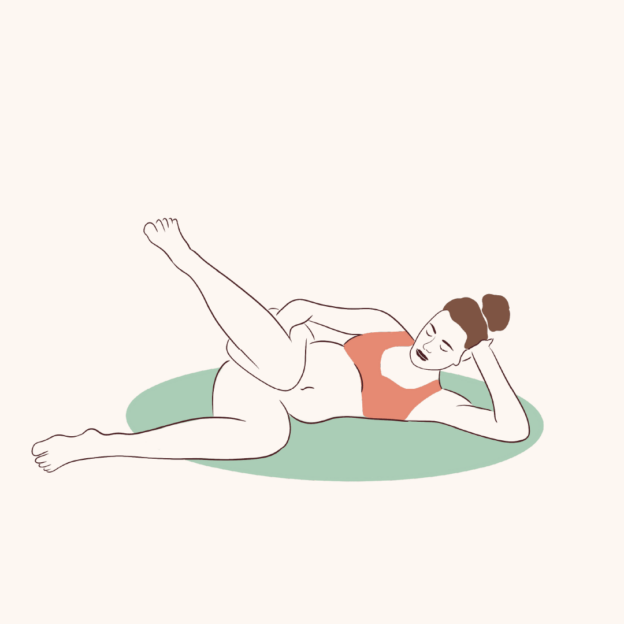
Auteur: Jiery van Roon
Datum: 4 oktober 2024
Wat is het beeld dat jij hebt bij een bevalling? Hoe gedraagt een barende zich, hoe beweegt ze, welke signalen geeft haar lijf? Het bekken van een zwangere zit ingenieus in elkaar, en werkt tijdens een fysiologische bevalling perfect samen met het lichaam van de baby. Verschillende lichaamshoudingen en bewegingen kunnen de afmetingen en flexibiliteit van het bekken beïnvloeden. Maar wat doen verschillende houdingen dan precies met de anatomie van het barende lichaam? Wat kunnen verschillende houdingen tijdens de bevalling betekenen voor de moeder en voor de baby? Hoe kun je verschillende houdingen gebruiken om het baringsproces te bevorderen? Deze en andere vragen worden beantwoord in dit artikel.
- Barrowclough, J., Lin, L., Kool, B., Hofmeyr, G. J., & Crowther, C. A. (2022). Maternal postures for fetal malposition in labour for improving the health of mothers and their infants. The Cochrane Library, 2022(8). https://doi.org/10.1002/14651858.cd014615
- Bick, D., Briley, A., Brocklehurst, P., Hardy, P., Juszczak, E., Lynch, L., MacArthur, C., Moore, P. A., Nolan, M., Rivero‐Arias, O., Sanders, J., Shennan, A., & Wilson, M. (2017). Upright versus lying down position in second stage of labour in nulliparous women with low dose epidural: BUMPES randomised controlled trial. The BMJ, j4471. https://doi.org/10.1136/bmj.j4471
- Bueno-Lopez, V., Fuentelsaz-Gallego, C., Casellas-Caro, M., Falgueras-Serrano, A. M., Crespo-Berros, S., Silvano-Cocinero, A. M., Alcaine-Guisado, C., Fuentes, M. G. B., Carreras, E., & Terré-Rull, C. (2018). Efficiency of the modified Sims maternal position in the rotation of persistent occiput posterior position during labor: A randomized clinical trial. Birth-issues in Perinatal Care, 45(4), 385–392. https://doi.org/10.1111/birt.12347
- Caglioni, M., Cantatore, F., Valsecchi, L., Miglioli, C., Dumont, R., Rinaldi, S., Candiani, M., & Salvatore, S. (2023). Effects of flexible sacrum position at birth on maternal and neonatal outcomes: A retrospective cohort study. International Journal of Gynaecology and Obstetrics. https://doi.org/10.1002/ijgo.14897
- De Jonge, A. (2008). Birthing positions revisited: examining the evidence for a routine practice. https://repository.ubn.ru.nl/handle/2066/72873
- De Jonge, A., & Lagro-Janssen, T. (2004). Opvattingen van vrouwen over verschillende baringshoudingen. Tijdschrift Voor Verloskundigen, 17–25.
- De Jonge, A., Teunissen, D., & Lagro-Janssen, A. L. M. (2004). Supine position compared to other positions during the second stage of labor: a meta-analytic review. Journal of Psychosomatic Obstetrics & Gynecology, 25(1), 35–45. https://doi.org/10.1080/01674820410001737423
- De Jonge, A., Van Diem, M. Th., Scheepers, P. L. H., Van Der Pal - De Bruin, K. M., & Lagro-Janssen, A. L. M. (2007). Toegenomen bloedverlies in verticale baringshouding veroorzaakt door perineumletsel. Tijdschrift Voor Verloskundigen, 29–37.
- Desbrière, R., Blanc, J., Dû, R. L., Renner, J., Carcopino, X., Loundou, A., & D’ercole, C. (2013). Is maternal posturing during labor efficient in preventing persistent occiput posterior position? A randomized controlled trial. American Journal of Obstetrics and Gynecology, 208(1), 60.e1-60.e8. https://doi.org/10.1016/j.ajog.2012.10.882
- Desseauve, D., Fradet, L., Lacouture, P., & Pierre, F. (2019). Is there an impact of feet position on squatting birth position? An innovative biomechanical pilot study. BMC Pregnancy and Childbirth, 19(1). https://doi.org/10.1186/s12884-019-2408-2
- Desseauve, D., Pierre, F. H., Fernández, A., Panjo, H., Decatoire, A., Lacouture, P., & Fradet, L. (2019). Assessment of Pelvic-Lumbar-Thigh biomechanics to Optimize the childbirth position: An “In Vivo” innovative biomechanical study. Scientific Reports, 9(1). https://doi.org/10.1038/s41598-019-52338-8
- Dokmak, F., Michałek, I. M., Boulvain, M., & Desseauve, D. (2020). Squatting position in the second stage of labor: A systematic review and meta-analysis. European Journal of Obstetrics & Gynecology and Reproductive Biology, 254, 147–152. https://doi.org/10.1016/j.ejogrb.2020.09.015
- Elvander, C., Ahlberg, M., Thies-Lagergren, L., Cnattingius, S., & Stephansson, O. (2015). Birth position and obstetric anal sphincter injury: a population-based study of 113 000 spontaneous births. BMC Pregnancy and Childbirth, 15(1). https://doi.org/10.1186/s12884-015-0689-7
- Engelmann, G. J. (1883). Labor Among Primitive Peoples (2nd ed.). J.H. Chambers & Co. https://books.google.nl/books?hl=nl&lr=&id=2j0JAAAAIAAJ&oi=fnd&pg=PR15&ots=pUohVspsfh&sig=3UwMFavt-hgv1Bu1fnCozm8kgHA&redir_esc=y#v=onepage&q&f=false
- Fenwick, L., & Simkin, P. (1987). Maternal positioning to prevent or alleviate dystocia in labor. Clinical Obstetrics and Gynecology, 30(1), 83–89. https://doi.org/10.1097/00003081-198703000-00012
- Gizzo, S., Di Gangi, S., Noventa, M., Bacile, V., Zambon, A., & Nardelli, G. B. (2014). Women’s Choice of Positions during Labour: Return to the Past or a Modern Way to Give Birth? A Cohort Study in Italy. BioMed Research International, 2014, 1–7. https://doi.org/10.1155/2014/638093
- Guittier, M., Othenin‐Girard, V., De Gasquet, B., Irion, O., & Boulvain, M. (2016). Maternal positioning to correct occiput posterior fetal position during the first stage of labour: a randomised controlled trial. BJOG: An International Journal of Obstetrics and Gynaecology, 123(13), 2199–2207. https://doi.org/10.1111/1471-0528.13855
- Gupta, J., Sood, A., Hofmeyr, G. J., & Vogel, J. P. (2017). Position in the second stage of labour for women without epidural anaesthesia. The Cochrane Library, 2017(5). https://doi.org/10.1002/14651858.cd002006.pub4
- Hemmerich, A., Bandrowska, T., & Dumas, G. (2019). The effects of squatting while pregnant on pelvic dimensions: A computational simulation to understand childbirth. Journal of Biomechanics, 87, 64–74. https://doi.org/10.1016/j.jbiomech.2019.02.017
- Hodnett, E., Stremler, R., Weston, J., & McKeever, P. (2009). Re‐Conceptualizing the Hospital Labor Room: The PLACE (Pregnant and Laboring in an Ambient Clinical Environment) pilot trial. Birth: Issues in Perinatal Care, 36(2), 159–166. https://doi.org/10.1111/j.1523-536x.2009.00311.x
- Hofmeyr, G. J., & Kulier, R. (2007). Hands and knees posture in late pregnancy or labour for fetal malposition (lateral or posterior). The Cochrane Library, 2009(1). https://doi.org/10.1002/14651858.cd001063.pub3
- Kemp, E. C., Kingswood, C. J., Kibuka, M., & Thornton, J. G. (2013). Position in the second stage of labour for women with epidural anaesthesia. Cochrane Database of Systematic Reviews. https://doi.org/10.1002/14651858.cd008070.pub2
- Kjeldsen, L. L., Blankholm, A. D., Jurik, A. G., Salvig, J. D., & Maimburg, R. D. (2021). Pelvic capacity in pregnant women, identified using magnetic resonance imaging. Acta Obstetricia Et Gynecologica Scandinavica, 100(8), 1454–1462. https://doi.org/10.1111/aogs.14168
- Kjeldsen, L. S., Blankholm, A., Jurik, A. G., Salvig, J. D., & Maimburg, R. D. (2021). Pelvic capacity in pregnant women, identified using magnetic resonance imaging. Acta Obstetricia Et Gynecologica Scandinavica, 100(8), 1454–1462. https://doi.org/10.1111/aogs.14168
- Kjeldsen, L. S., Dahlen, H., & Maimburg, R. D. (2022). Expectations of the upcoming birth – A survey of women’s self-efficacy and birth positions. Sexual & Reproductive Healthcare, 34, 100783. https://doi.org/10.1016/j.srhc.2022.100783
- KNOV. (2006). Richtlijn niet-vorderende ontsluiting. https://www.knov.nl. Retrieved July 18, 2023, from https://www.knov.nl/kennis-en-scholing/richtlijnen-en-standaarden/richtlijn/niet-vorderende-ontsluiting-knov-standaard
- KNOV. (2012). Handreiking baringshoudingen tijdens de uitdrijving. www.knov.nl. Retrieved July 18, 2023, from https://www.knov.nl/zoeken/document?documentRegistrationId=10289176 KNOV. (2023). Wetenschappelijk advies over Baringshouding en Perineum letsel. In https://www.knov.nl/actueel/nieuws/nieuwsbericht/wetenschappelijk-advies-baringshouding-en-perineum.
- Levy, A., Weingarten, S. J., Ali, A. S., Quist-Nelson, J., & Berghella, V. (2021). Hands-and-knees posturing and fetal occiput anterior position: a systematic review and meta-analysis. American Journal of Obstetrics and Gynaecology, 3(4), 100346. https://doi.org/10.1016/j.ajogmf.2021.100346
- Meyvis, I., Van Rompaey, B., Goormans, K., Truijen, S., Lambers, S., Mestdagh, E., & Mistiaen, W. (2012). Maternal position and other variables: Effects on perineal outcomes in 557 births. Birth: Issues in Perinatal Care, 39(2), 115–120. https://doi.org/10.1111/j.1523-536x.2012.00529.x
- Michel, S., Rake, A., Treiber, K., Seifert, B., Chaoui, R., Huch, R., Marinček, B., & Kubik‐Huch, R. A. (2002). MR Obstetric Pelvimetry: Effect of birthing position on pelvic bony Dimensions. American Journal of Roentgenology, 179(4), 1063–1067. https://doi.org/10.2214/ajr.179.4.1791063
- Nieuwenhuijze, M., Low, L. K., Korstjens, I., & Lagro‐Janssen, T. (2014). The role of maternity care providers in promoting shared decision making regarding birthing positions during the second stage of labor. Journal of Midwifery & Women’s Health, 59(3), 277–285. https://doi.org/10.1111/jmwh.12187
- NVOG. (2013). NVOG-richtlijn Spontane vaginale baring. Retrieved July 19, 2023, from https://www.nvog.nl/wp-content/uploads/2018/02/Spontane-vaginale-baring-2.0-14-11-2013.pdf
- Paternotte, J., Potin, J., Diguisto, C., Neveu, M., & Perrotin, F. (2012). Accouchement sur le côté. Étude comparative chez les grossesses à bas risque entre décubitus latéral et dorsal lors de la phase expulsive des accouchements eutociques. Gynecologie Obstetrique & Fertilite, 40(5), 279–283. https://doi.org/10.1016/j.gyobfe.2011.07.039
- Perined. (2022). Peristat. Retrieved February 29, 2024, from https://www.peristat.nl/
- Ragnar, I., Altman, D. G., Tydén, T., & Olsson, S. B. (2006). Comparison of the maternal experience and duration of labour in two upright delivery positions-a randomised controlled trial. Bjog: An International Journal of Obstetrics and Gynaecology, 113(2), 165–170. https://doi.org/10.1111/j.1471-0528.2005.00824.x
- Ray, C. L., Lepleux, F., De La Calle, A., Guerin, J., Sellam, N., Dreyfus, M., & Chantry, A. (2016). Lateral asymmetric decubitus position for the rotation of occipito-posterior positions: multicenter randomized controlled trial EVADELA. American Journal of Obstetrics and Gynecology, 215(4), 511.e1-511.e7. https://doi.org/10.1016/j.ajog.2016.05.033
- Reed, R. (2022, April 26). In celebration of the OP baby. Midwife Thinking. Retrieved July 19, 2023, from https://midwifethinking.com/2016/06/08/in-celebration-of-the-op-baby/
- Reitter, A., Daviss, B., Bisits, A., Schollenberger, A., Vogl, T. J., Herrmann, E., Louwen, F., & Zangos, S. (2014a). Does pregnancy and/or shifting positions create more room in a woman’s pelvis? American Journal of Obstetrics and Gynecology, 211(6), 662.e1-662.e9. https://doi.org/10.1016/j.ajog.2014.06.029
- Reitter, A., Daviss, B., Bisits, A., Schollenberger, A., Vogl, T. J., Herrmann, E., Louwen, F., & Zangos, S. (2014b). Does pregnancy and/or shifting positions create more room in a woman’s pelvis? American Journal of Obstetrics and Gynecology, 211(6), 662.e1-662.e9. https://doi.org/10.1016/j.ajog.2014.06.029
- Roberts, J., Mendez-Bauer, C., & Wodell, D. A. (1983). The effects of maternal position on uterine contractility and efficiency. Birth-issues in Perinatal Care, 10(4), 243–250. https://doi.org/10.1111/j.1523-536x.1983.tb01433.x
- Shorey, S., Chan, V., & Lalor, J. (2021). Perceptions of women and partners on labor and birth positions: A meta‐synthesis. Birth: Issues in Perinatal Care, 49(1), 19–29. https://doi.org/10.1111/birt.12574
- Shorten, A., Donsante, J., & Shorten, B. (2002). Birth position, accoucheur, and perineal outcomes: Informing women about choices for vaginal birth. Birth: Issues in Perinatal Care, 29(1), 18–27. https://doi.org/10.1046/j.1523-536x.2002.00151.x
- Simkin, P. (2010). The Fetal occiput Posterior Position: State of the Science and a new perspective. Birth: Issues in Perinatal Care, 37(1), 61–71. https://doi.org/10.1111/j.1523-536x.2009.00380.x
- Simkin, P., Hanson, L., & Ancheta, R. (2017). The Labor Progress Handbook: Early interventions to prevent and treat dystocia (4th ed.). Wiley Blackwell.
- Soong, B., & Barnes, M. (2005). Maternal position at Midwife‐Attended Birth and perineal trauma: Is there an association? Birth: Issues in Perinatal Care, 32(3), 164–169. https://doi.org/10.1111/j.0730-7659.2005.00365.x
- Suraci, N., Carr, C. M., Peck, J., Hoyos, J., & Rosen, G. M. (2019). Improving labour progression among women with epidural anesthesia following use of a birthing ball: a review of recent literature. Journal of Obstetrics and Gynaecology, 40(4), 491–494. https://doi.org/10.1080/01443615.2019.1633519
- Thies-Lagergren, L., Uldbjerg, T., & Maimburg, R. D. (2020). Genital tract tears in women giving birth on a birth seat: A cohort study with prospectively collected data. Women and Birth, 33(1), 15–21. https://doi.org/10.1016/j.wombi.2018.12.006
- Walker, K. F., Kibuka, M., Thornton, J., & Jones, N. (2018). Maternal position in the second stage of labour for women with epidural anaesthesia. The Cochrane Library, 2018(11). https://doi.org/10.1002/14651858.cd008070.pub4
- Walsh, D. (2012). Evidence and skills for normal labour and birth. In Routledge eBooks (2nd ed.). Routledge. https://doi.org/10.4324/9780203357361
- Warmink-Perdijk, W. D., Koelewijn, J. M., De Jonge, A., Van Diem, M. T., & Lagro-Janssen, A. L. M. (2016). Better perineal outcomes in sitting birthing position cannot be explained by changing from upright to supine position for performing an episiotomy. Midwifery, 34, 1–6. https://doi.org/10.1016/j.midw.2016.01.010
- WHO. (2018). WHO recommendations: intrapartum care for a positive childbirth experience. Geneva: World Health Organization. https://www.who.int/publications/i/item/9789241550215
- Zhang, H., Huang, S., Guo, X., Zhao, N., Lu, Y., Chen, M., Li, Y., Wu, J., Huang, L., Ma, F., Yang, Y., Zhang, X., Zhou, X., Guo, R., & Cai, W. (2017). A randomised controlled trial in comparing maternal and neonatal outcomes between hands-and-knees delivery position and supine position in China. Midwifery, 50, 117–124. https://doi.org/10.1016/j.midw.2017.03.022
>



